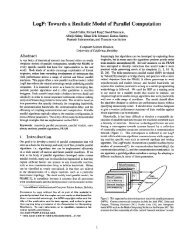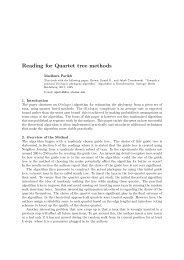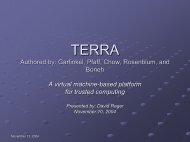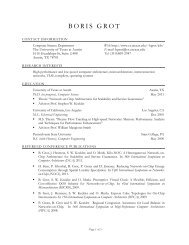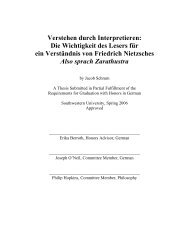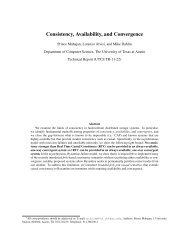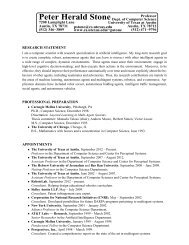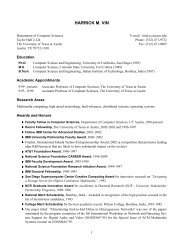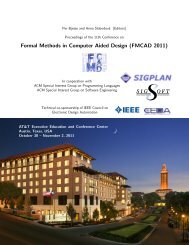A User's Guide to gringo, clasp, clingo, and iclingo
A User's Guide to gringo, clasp, clingo, and iclingo
A User's Guide to gringo, clasp, clingo, and iclingo
Create successful ePaper yourself
Turn your PDF publications into a flip-book with our unique Google optimized e-Paper software.
5 course(5,1,4). course(5,4,4).<br />
6 course(6,2,2). course(6,3,2).<br />
7 course(7,2,4). course(7,3,4). course(7,4,4).<br />
8 course(8,3,5). course(8,4,5).<br />
In an instance of course/3, the first argument is a number identifying one of the eight<br />
courses, <strong>and</strong> the third argument provides the course’s contact hours per week. The second<br />
argument st<strong>and</strong>s for a subject area: 1 corresponding <strong>to</strong> “theoretical informatics,”<br />
2 <strong>to</strong> “practical informatics,” 3 <strong>to</strong> “technical informatics,” <strong>and</strong> 4 <strong>to</strong> “applied informatics.”<br />
For instance, a<strong>to</strong>m course(1,2,5) expresses that course 1 accounts for 5<br />
contact hours per week that may be credited <strong>to</strong> subject area 2 (“practical informatics”).<br />
Observe that a single course is usually eligible for multiple subject areas.<br />
After specifying the above facts, the student starts <strong>to</strong> provide personal constraints<br />
on the courses <strong>to</strong> enroll. The first condition is that 3 <strong>to</strong> 6 courses should be enrolled:<br />
9 3 { enroll(C) : course(C,_,_) } 6.<br />
Instantiating the above #count aggregate yields the following ground rule: The full ground program is ob-<br />
9 3 { enroll(1), enroll(2), enroll(3), enroll(4),<br />
enroll(5), enroll(6), enroll(7), enroll(8) } 6.<br />
Observe that an instance of a<strong>to</strong>m enroll(C) is included for each instantiation of C<br />
such that course(C,S,H) holds for some values of S <strong>and</strong> H. Duplicates resulting<br />
from distinct values for S are removed, thus, obtaining the above set of ground a<strong>to</strong>ms.<br />
The next constraints of the student regard the subject areas of enrolled courses:<br />
10 :- [ enroll(C) : course(C,_,_) ] 10.<br />
11 :- 2 [ not enroll(C) : course(C,2,_) ].<br />
12 :- 6 [ enroll(C) : course(C,3,_), enroll(C) : course(C,4,_) ].<br />
Each of the three integrity constraints above contains a sum aggregate, using default<br />
weight 1 for literals. Recalling that #sum aggregates operate on multisets, duplicates<br />
are not removed. Thus, the integrity constraint in Line 10 is instantiated as follows:<br />
10 :- [ enroll(1) = 1, enroll(1) = 1,<br />
enroll(2) = 1, enroll(2) = 1,<br />
enroll(3) = 1, enroll(3) = 1,<br />
enroll(4) = 1, enroll(4) = 1, enroll(4) = 1,<br />
enroll(5) = 1, enroll(5) = 1,<br />
enroll(6) = 1, enroll(6) = 1,<br />
enroll(7) = 1, enroll(7) = 1, enroll(7) = 1,<br />
enroll(8) = 1, enroll(8) = 1 ] 10.<br />
Note that courses 4 <strong>and</strong> 7 count three times because they are eligible for three subject<br />
areas, viz., there are three distinct instantiations for S in course(4,S,3) <strong>and</strong><br />
course(7,S,4), respectively. Comparing the above ground instance, the meaning<br />
of the integrity constraint in Line 10 is that the number of eligible subject areas over all<br />
enrolled courses must be more than 10. Similarly, the integrity constraint in Line 11<br />
expresses the requirement that at most one course of subject area 2 (“practical informatics”)<br />
is not enrolled, while Line 12 stipulates that the enrolled courses amount <strong>to</strong><br />
less than six nominations of subject area 3 (“technical informatics”) or 4 (“applied<br />
informatics”). Also note that, given the facts in Line 1–8, we could equivalently have<br />
used count rather than sum in Line 11, but not in Line 10 <strong>and</strong> 12.<br />
20<br />
tained by invoking:<br />
<strong>gringo</strong> -t



